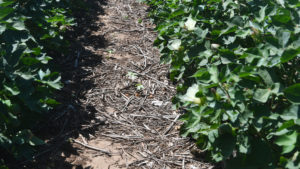More mature cover crops help maintain residue longer
Water use will be replaced on irrigated cotton
Writer: Kay Ledbetter, 806-677-5608, [email protected]
Contact: Dr. Paul DeLaune, 940-552-9941, [email protected]
CHILLICOTHE – Often producers planting cover crops are worried about moisture use, but more important is the longevity of the crop residue and its beneficial results, said a Texas A&M AgriLife Research scientist.

Dr. Paul DeLaune, an AgriLife Research environmental soil scientist at Vernon, said when he talks about the residue management of cover crops, one question he always gets concerns termination timing and the use of soil moisture by the cover crop.
Cover crops are designed to keep soil from blowing and improve soil quality. DeLaune has included Austrian winter field pea, hairy vetch, crimson clover, wheat, rye, turnips and radishes as cover crops in the various studies.
“We use neutron probes here to monitor soil moisture year-round, and yes, the cover crop does use soil moisture,” he said. “But one thing we’ve found is that soil moisture is quickly recharged and your crop is back to status quo if you get a rain between termination and the planting of your cotton.”
This information is based on eight different cover crop studies by AgriLife Research in the Rolling Plains where soil moisture is monitored throughout the year, some continuously since 2012, he said, discussing the studies at the recent Rolling Plains Summer Field Day in Chillicothe.
More important, he said, is the termination timing of that cover crop. In comparing two different termination timings utilizing a wheat cover crop, he said the duration of the residue is increased with the maturity of the wheat.

“I like to let it go ahead and mature out to about 50 percent heading or so, and then plant cotton four to six weeks after termination,” DeLaune said. “This year, we had to terminate a little earlier due to a drift issue – mid-March versus toward the end of April.
“What we determined is if you terminate too early, you’re not going to have lasting residue. The residue in a vegetative stage degrades very rapidly. If you can allow wheat to reach heading, you can see lasting residue for about 18 months.”
So for those producers who are working with a cover crop, his advice is to consider delaying termination timing to ensure it results in lasting residue.
“Your soil moisture will be replenished, especially if it is on irrigated cotton, and it will pay off in the long term to build up your soil organic matter in your system,” DeLaune said. “It will cover your soil and protect your soil much longer.
“Although soil organic matter is slow to build up in our environments, we have seen more immediate impacts off cover crops on soil physical properties such as soil strength and infiltration,” he said. “Within the Rolling Plains, we have not observed depleted soil moisture behind cover crops during wheat and cotton growing seasons in dryland cropping systems.”
DeLaune said he understands there is greater risk in dryland systems and drier environments moving further west. However, Dr. Katie Lewis, AgriLife Research soil scientist at Lubbock, has noted the same trends in irrigated cotton systems at Lamesa.
Both locations will continue to evaluate cover crops, he said.


